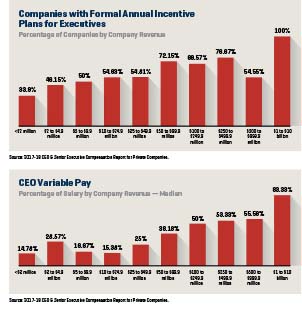 Executive compensation is one of the biggest investments most companies make, yet far too few approach it strategically. A compensation plan should be about more than simply paying competitive salaries and bonuses—it should be designed to encourage executives to work together to build long-term enterprise value.
Executive compensation is one of the biggest investments most companies make, yet far too few approach it strategically. A compensation plan should be about more than simply paying competitive salaries and bonuses—it should be designed to encourage executives to work together to build long-term enterprise value.
Since Chief Executive began reporting on private company executive compensation six years ago, we have consistently found that too many companies provide modest annual salary and bonus increases across the board, rewarding for tenure versus performance.
So how should CEOs approach executive pay? Here are four steps to get you started.
View compensation as a strategic tool
To develop a strategic executive compensation plan, business owners must first determine the business’s priorities—increased cash flow, positioning for a potential sale or IPO, increased equity value—and then establish goals, time horizons and measurable success metrics.
“58% of companies do not have a formal long-term incentive plan.”
Once a company has set clear and measurable objectives, the plan must be communicated to senior executives so they understand the value of their performance-based compensation—and know what is expected of them to earn their annual salary increases and bonuses. Here are some steps to follow.
Define your compensation philosophy
To craft a successful plan, define your pay philosophy by answering the following questions:
• Is the company going to pay for performance versus tenure?
• Who is competing against you for talent for each position?
• Which positions require top talent and which require average performers?
The answers may vary by type of company. A tech company, for example, may want a rock star head of R&D, but only need a solid VP of sales. Conversely, a manufacturer focused on cash flow may want a great COO or CFO, but only need an average head of engineering.
 Craft a specific compensation plan
Craft a specific compensation plan
Next, determine how much cash from annual profits can be allocated to incentive programs. Be sure to account for new hires or other employees who may be added to the plan and then choose incentive vehicles accordingly.
Choose an optimal plan for your company
Not all companies can offer equity or stock options. But family-owned businesses, for example, can provide phantom equity plans or long-term cash incentives to encourage key execs to build enterprise value. Profitable companies may opt for cash incentives rather than diluting shareholders’ equity, while early-stage companies may
want to use limited cash to fuel investments and provide compensation in equity or stock options.
Strategic compensation plans can make the difference between lackluster performance and sustained growth Unfortunately, our upcoming 2017-2018 CEO & Senior Executive Compensation Report for Private Companies finds that too few companies use compensation as a strategic tool. Nearly 58 percent of companies lack a formal long-term incentive plan, and of those that do, only 32 percent use performance-based vesting rather than time-based vesting.
These companies are missing an opportunity to tie top performers’ compensation to results and, just as important, to send a message to under performers.
For more information about the report, visit Research.ChiefExecutive.net/compreport.
Chief Executive Group exists to improve the performance of U.S. CEOs, senior executives and public-company directors, helping you grow your companies, build your communities and strengthen society. Learn more at chiefexecutivegroup.com.
0

1:00 - 5:00 pm
Over 70% of Executives Surveyed Agree: Many Strategic Planning Efforts Lack Systematic Approach Tips for Enhancing Your Strategic Planning Process
Executives expressed frustration with their current strategic planning process. Issues include:
Steve Rutan and Denise Harrison have put together an afternoon workshop that will provide the tools you need to address these concerns. They have worked with hundreds of executives to develop a systematic approach that will enable your team to make better decisions during strategic planning. Steve and Denise will walk you through exercises for prioritizing your lists and steps that will reset and reinvigorate your process. This will be a hands-on workshop that will enable you to think about your business as you use the tools that are being presented. If you are ready for a Strategic Planning tune-up, select this workshop in your registration form. The additional fee of $695 will be added to your total.

2:00 - 5:00 pm
Female leaders face the same issues all leaders do, but they often face additional challenges too. In this peer session, we will facilitate a discussion of best practices and how to overcome common barriers to help women leaders be more effective within and outside their organizations.
Limited space available.

10:30 - 5:00 pm
General’s Retreat at Hermitage Golf Course
Sponsored by UBS
General’s Retreat, built in 1986 with architect Gary Roger Baird, has been voted the “Best Golf Course in Nashville” and is a “must play” when visiting the Nashville, Tennessee area. With the beautiful setting along the Cumberland River, golfers of all capabilities will thoroughly enjoy the golf, scenery and hospitality.
The golf outing fee includes transportation to and from the hotel, greens/cart fees, use of practice facilities, and boxed lunch. The bus will leave the hotel at 10:30 am for a noon shotgun start and return to the hotel after the cocktail reception following the completion of the round.